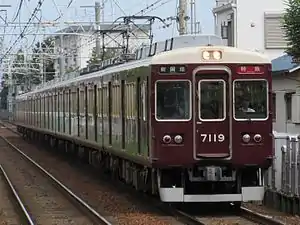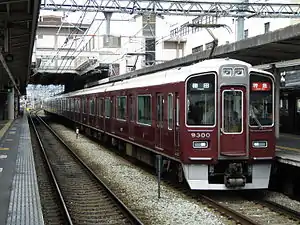Hankyu 7000 series
The Hankyu 7000 series (阪急電鉄7000系) is an electric multiple unit (EMU) train type operated in Japan by the private railway operator Hankyu since 1980.[1]
| Hankyu 7000 series | |
|---|---|
 Hankyu 7119 at Okamoto Station on a service to Shinkaichi | |
| In service | 1980– |
| Manufacturer | Alna Kōki |
| Constructed | 1980–1988 |
| Entered service | 1990 |
| Refurbished | 1998, 2009 |
| Number built | 210 vehicles |
| Number in service | 202 vehicles (Hankyu Railway) 8 vehicles (Nose Electric Railway) |
| Formation | 2/4/6/8 cars per trainset |
| Fleet numbers | 7001–7027, 7030–7037 |
| Operator(s) | Hankyu Railway Nose Electric Railway |
| Depot(s) | Hirai, Nishinomiya |
| Line(s) served | |
| Specifications | |
| Car body construction | SteelAluminum (Sets 7021 and later) |
| Car length | 19,000 mm (62 ft 4 in) |
| Width | 2,750 mm (9 ft 0 in) |
| Height | 4,095 mm (13 ft 5.2 in) |
| Doors | 3 pairs per side |
| Maximum speed | 115 km/h (70 mph) (Kyoto and Kobe Lines) 130 km/h (80 mph) (Design) |
| Traction system | DC compound motor |
| Power output | 150 kW (200 hp) per motor |
| Acceleration | 2.8 km/h/s |
| Deceleration | 3.7 km/h/s (operation) 4.2 km/h/s (emergency) |
| Electric system(s) | 1,500 V DC overhead catenary |
| Current collection method | Pantograph |
| Bogies | Minden German style direct mount air spring bogie FS-369A (M car) |
| Braking system(s) | Dynamic brake Electronically controlled pneumatic brakes |
| Safety system(s) | ATS |
| Coupling system | Shibata-type Knuckle-type |
| Multiple working | 7300 series, 8000 series, |
| Track gauge | 1,435 mm (4 ft 8 1⁄2 in) |
Overview
The 7000 series were built between 1980 and 1988 by Japanese rolling stock manufacturer Alna Koki.[2] This type is the most common in the Hankyu fleet at 210 cars.
The trains are based on the previous 6000 series. In addition, the 7300 series are a derivative of the 7000 series.[1]
Formations
8-car sets
As of November 2020, there are 19 eight–car sets enrolled in the roster.[3] 16 sets are allocated to Kobe line services while three sets are set aside for service on the Takarazuka Line.
| Car No. | 1 | 2 | 3 | 4 | 5 | 6 | 7 | 8 |
|---|---|---|---|---|---|---|---|---|
| Designation | Mc | M' | T | T | T | T | M | M'c |
| Numbering | Mc 7000 | M 7500 | T 7550 | T 7550 | T 7550 | T 7550 | M 7600 | Mc 7100 |
- The "Mc" and "M" cars are fitted with two scissors-type pantographs.
Kobe Line 8–car mixed 7000/8000 series sets
In June 2019, set 8042 was transferred over to Kobe Line operations and attached to 6-car set 7001.[3][4]
| Car No. | 1 | 2 | 3 | 4 | 5 | 6 | 7 | 8 |
|---|---|---|---|---|---|---|---|---|
| Designation | Mc1 | Tc | Mc | M' | T | T | M | M'c |
| Numbering | Mc 8000 | Tc 8150 | Mc 7000 | M 7500 | T 7550 | T 7550 | M 7600 | Mc 7100 |
Takarazuka Line 8–car mixed 7000/8000 series set
In 2016, two–car sets 7025 and 7026 and four–car set 7024 underwent inspection. In April 2017, two–car set 7025 was connected to two 6000 series cars and transferred to Nose Electric Railway as a four-car formation leaving 7024 and 7026 as a six–car set along with 8000 series two-car set 8030.[5] Later in August, two–car set 7026 was divided from the train along with two-car set 8030.[3] The resulting trainset is a 2–2–4 set with two-car sets 8040 and 8041 and four-car set 7024.[6]
| Car No. | 1 | 2 | 3 | 4 | 5 | 6 | 7 | 8 |
|---|---|---|---|---|---|---|---|---|
| Designation | Mc1 | Tc | Mc1 | Tc | Mc | T | T | M'c |
| Numbering | Mc 8000 | Tc 8150 | Mc 8000 | Tc 8150 | Mc 7000 | T 7550 | T 7550 | Mc 7100 |
Kobe Line 4–car set
In March 2016, two-car sets 7034 and 7035 were combined to make a semi–permanent four–car train.[5]
| Car No. | 1 | 2 | 3 | 4 |
|---|---|---|---|---|
| Designation | Mc | Tc | Mc | Tc |
| Numbering | Mc 7000 | Tc 7150 | Mc 7000 | Tc 7150 |
 Four-car set 7034 on a local service
Four-car set 7034 on a local service
Takarazuka Line 4–car set
In August 2019, two-car 7031 was connected to two cars formerly belonging to Kobe line set 6050 to form a four–car set for the Minoo Line.[7]
| Car No. | 1 | 2 | 3 | 4 |
|---|---|---|---|---|
| Designation | Mc | T | M | Tc |
| Numbering | Mc 7000 | T 7550 | M 7600 | Tc 7150 |
Nose Electric Railway 4–car set
The set is currently at Amagasaki Vehicle Plant for maintenance[8]
| Car No. | 1 | 2 | 3 | 4 |
|---|---|---|---|---|
| Designation | Mc | T | M | M'c |
| Numbering | Mc 7000 | T 7550 | M 7600 | Mc 7100 |
2–car sets
| Car No. | 1 | 2 |
|---|---|---|
| Designation | Mc | Tc |
| Numbering | Mc 7000 | Tc 7150 |
- The "Mc" car is fitted with two scissors-type pantographs.
Interior
Passenger accommodation consists of longitudinal seating throughout. Paneling inside the car is composed of a light-brown faux wood finish.
Kyo-Train "Garaku"
On May 22, 2018, Hankyu announced that they would be introducing a second train to their Kyo-Train lineup. It would be composed of six-car set 7006. The train was named the "Kyo-Train Garaku" in December of that year and entered service a month after that.[9][10] This set has the middle door removed on all cars, effectively making it two doors per side per car.
| Car No. | 1 | 2 | 3 | 4 | 5 | 6 |
|---|---|---|---|---|---|---|
| Designation | Mc | M' | T | T | M | M'c |
| Numbering | Mc 7000 | M 7500 | T 7550 | T 7550 | M 7600 | Mc 7100 |
 Kyo-Train "Garaku" set 7006
Kyo-Train "Garaku" set 7006 Interior of car 1
Interior of car 1
Nose Electric Railway 7200 series
As of April 2020, two four-car sets operate for Nose Electric Railway as 7200 series.[11]
| Car No. | 1 | 2 | 3 | 4 |
|---|---|---|---|---|
| Designation | Mc | M' | T | Tc |
| Numbering | Mc 7000 | T 7550 | M 7600 | Tc 7150 |
 Four-car set 7200 (former 7025) set testing in 2018
Four-car set 7200 (former 7025) set testing in 2018 Inside of car 7250
Inside of car 7250
Gallery
 Lone 8-car refurbished set 7007 featuring alternative front end design
Lone 8-car refurbished set 7007 featuring alternative front end design Hankyu 7117 on a service to Shinkaichi
Hankyu 7117 on a service to Shinkaichi_IMG_4577-2_140830.JPG.webp) Interior of car 7503
Interior of car 7503 Eight-car set 7003 in 1988
Eight-car set 7003 in 1988
References
- 山口, 益生 (29 June 2012). 阪急電車 [Hankyu Train] (in Japanese). Tokyo, Japan: JTB Publishing. p. 230. ISBN 978-4533086984.CS1 maint: date and year (link)
- 山口, 益生 (29 June 2012). 阪急電車 [Hankyu Train] (in Japanese). Tokyo, Japan: JTB Publishing. pp. 205–207. ISBN 978-4533086984.CS1 maint: date and year (link)
- "Hankyu Railway Fan Club Bulletin". Hankyu Railway. 90.
- "阪急8000系8042編成が神戸線へ" [Hankyu 8000 Series 8042 Formation to Kobe line]. railf.jp (in Japanese). 20 June 2019. Retrieved 31 January 2021.
- 恒雄, 高間 (2017). 阪急電鉄の車両動向2017 [Hankyu Railway Vehicle Trends 2017] (in Japanese). Japan: 交友社. p. 77.
- "Hankyu Railway Fan Club Bulletin". Hankyu Railway. 91.
- "阪急7000系7031編成が箕面線の運用に" [^ Hankyu 7000 series 7031 formation]. railf.jp (in Japanese). 20 June 2019. Retrieved 31 January 2021.
- "【阪急】7000系7026F阪神車両メンテナンスへ回送" [[Hankyu] 7000 series 7026F Forwarded to Hanshin vehicle maintenance]. 2nd-train.net (in Japanese). 26 April 2020.
- 岡本好史・川嶋隆一 (ed.). "阪急電鉄7000系「京とれいん 雅洛」" [Railway Pictorial 2019 August issue]. 鉄道ピクトリアル2019年8月号 (in Japanese). 電気車研究会: 114–119. ASIN B07RN382P5.
- "Kyo-Train GARAKU". hankyu.co.jp. Retrieved 31 January 2020.
- 信彦, 松田 (20 March 2018). "【能勢電鉄】7200系営業運転開始" [[Nose Electric Railway] 7200 Series Commercial Operation Started]. rail.hobidas.com (in Japanese). Archived from the original on 3 April 2019. Retrieved 31 January 2021.
| Wikimedia Commons has media related to Hankyu 6000 series. |
